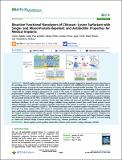Por favor, use este identificador para citar o enlazar a este item:
http://hdl.handle.net/10261/244904COMPARTIR / EXPORTAR:
 SHARE SHARE
 CORE
BASE CORE
BASE
|
|
| Visualizar otros formatos: MARC | Dublin Core | RDF | ORE | MODS | METS | DIDL | DATACITE | |

| Título: | Bioactive Functional Nanolayers of Chitosan–Lysine Surfactant with Single- and Mixed-Protein-Repellent and Antibiofilm Properties for Medical Implants |
Autor: | Ajdnik, Urban; Zemljič, Lidija Fras; Plohl, Olivija; Pérez, Lourdes CSIC ORCID ; Trček, Janja; Bračič, Matej; Mohan, Tamilselvan | Palabras clave: | Silicone implants Antimicrobial Chitosan Protein-repellent |
Fecha de publicación: | 17-may-2021 | Editor: | American Chemical Society | Citación: | ACS Applied Materials and Interfaces 13 (20): 23352–23368 (2021) | Resumen: | Medical implant-associated infections resulting from biofilm formation triggered by unspecific protein adsorption are the prevailing cause of implant failure. However, implant surfaces rendered with multifunctional bioactive nanocoatings offer a promising alternative to prevent the initial attachment of bacteria and effectively interrupt biofilm formation. The need to research and develop novel and stable bioactive nanocoatings for medical implants and a comprehensive understanding of their properties in contact with the complex biological environment are crucial. In this study, we developed an aqueous stable and crosslinker-free polyelectrolyte–surfactant complex (PESC) composed of a renewable cationic polysaccharide, chitosan, a lysine-based anionic surfactant (77KS), and an amphoteric antibiotic, amoxicillin, which is widely used to treat a number of infections caused by bacteria. We successfully introduced the PESC as bioactive functional nanolayers on the “model” and “real” polydimethylsiloxane (PDMS) surfaces under dynamic and ambient conditions. Besides their high stability and improved wettability, these uniformly deposited nanolayers (thickness: 44–61 nm) with mixed charges exhibited strong repulsion toward three model blood proteins (serum albumin, fibrinogen, and γ-globulin) and their competitive interactions in the mixture in real-time, as demonstrated using a quartz crystal microbalance with dissipation (QCM-D). The functional nanolayers with a maximum negative zeta potential (ζ: −19 to −30 mV at pH 7.4), water content (1628–1810 ng cm–2), and hydration (low viscosity and elastic shear modulus) correlated with the mass, conformation, and interaction nature of proteins. In vitro antimicrobial activity testing under dynamic conditions showed that the charged nanolayers actively inhibited the growth of both Gram-negative (Escherichia coli) and Gram-positive (Staphylococcus aureus) bacteria compared to unmodified PDMS. Given the ease of fabrication of multifunctional and charged biobased coatings with simultaneous protein-repellent and antimicrobial activities, the limitations of individual approaches could be overcome leading to a better and advanced design of various medical devices (e.g., catheters, prosthetics, and stents). | Versión del editor: | https://doi.org/10.1021/acsami.1c01993 | URI: | http://hdl.handle.net/10261/244904 | DOI: | 10.1021/acsami.1c01993 |
| Aparece en las colecciones: | (IQAC) Artículos |
Ficheros en este ítem:
| Fichero | Descripción | Tamaño | Formato | |
|---|---|---|---|---|
| acsami.1c01993.pdf | Artículo principal | 4,2 MB | Adobe PDF |  Visualizar/Abrir |
CORE Recommender
PubMed Central
Citations
4
checked on 14-mar-2024
SCOPUSTM
Citations
15
checked on 19-abr-2024
WEB OF SCIENCETM
Citations
12
checked on 24-feb-2024
Page view(s)
58
checked on 22-abr-2024
Download(s)
121
checked on 22-abr-2024
Google ScholarTM
Check
Altmetric
Altmetric
Artículos relacionados:
NOTA: Los ítems de Digital.CSIC están protegidos por copyright, con todos los derechos reservados, a menos que se indique lo contrario.
